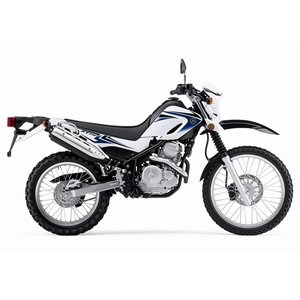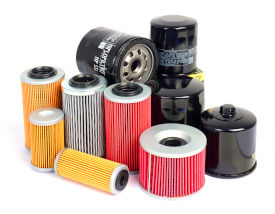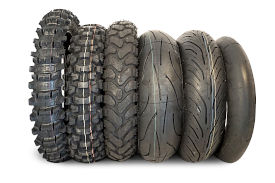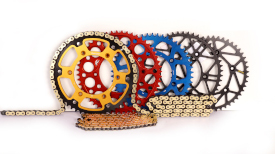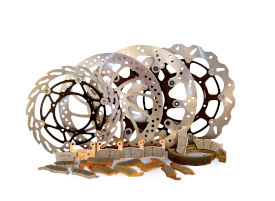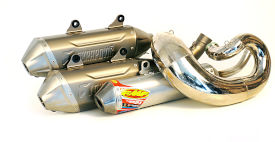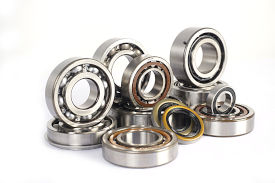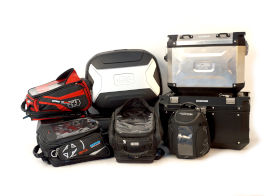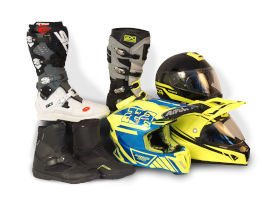Yamaha XT 250 (2008-2023) Review: The Unassuming Dual-Sport That Outlasts Trends
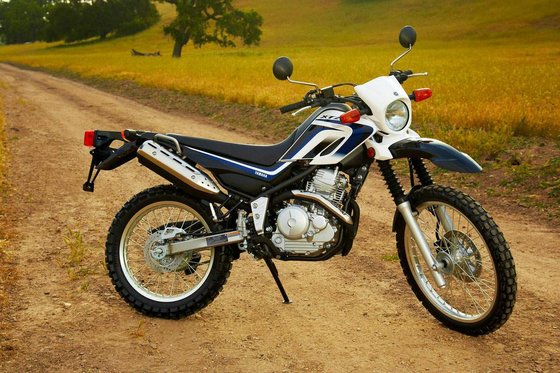
Introduction
The Yamaha XT 250 is a study in consistency. Produced from 2008 to 2023 with minimal changes, this dual-sport motorcycle has carved out a niche as a reliable, approachable companion for riders who value simplicity over spectacle. It’s not the fastest, flashiest, or most technologically advanced bike in its class—and that’s precisely its appeal. Whether navigating urban grids, gravel backroads, or forest trails, the XT 250 thrives on a philosophy of “enough.” After spending time with this enduring machine, it’s clear why Yamaha kept the formula unchanged for over 15 years: it just works.
Riding Experience: Where Modesty Becomes a Virtue
On-Road Manners
Climbing onto the XT 250 feels like reuniting with an old friend. The 31.9-inch (810mm) seat height is forgiving for riders of all statures, and the 291-pound (132kg) wet weight makes it feel flickable in traffic. The air-cooled 249cc SOHC single-cylinder engine delivers predictable power, with 18 hp peaking at 7,500 RPM and a friendly 19 Nm of torque at 6,500 RPM. Acceleration won’t pin you to the seat, but the fuel-injected (post-2013 models) motor pairs seamlessly with the 5-speed gearbox for smooth urban commutes. At 70 mph (112 km/h), the engine hums comfortably, though sustained highway riding isn’t its forte. The real joy comes from its frugality: 75 mpg (3.1L/100km) means 200+ miles (322km) from its 2.6-gallon (9.8L) tank.
Off-Road Prowess
Swap pavement for dirt, and the XT 250 transforms. The 21-inch front and 18-inch spoked wheels roll confidently over ruts, while 11.2 inches (284mm) of ground clearance shrugs off rocks and logs. Suspension travel—8.9 inches (226mm) up front and 7.1 inches (180mm) at the rear—absorbs moderate jumps and whoops, though aggressive riders might crave more damping control. The Nissin disc brakes (245mm front/203mm rear) offer ample stopping power, and the semi-double-cradle steel frame strikes a balance between rigidity and flex. It’s not a motocross weapon, but for exploring fire roads or navigating tight singletrack, few bikes feel this unintimidating.
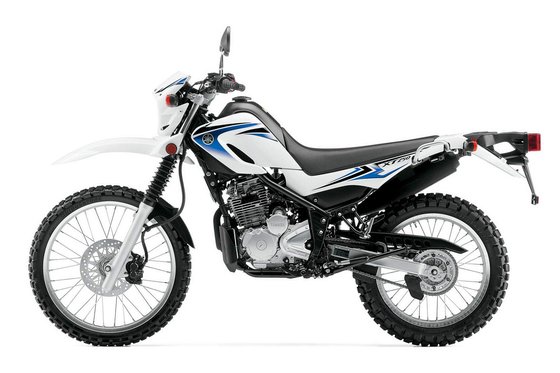
Design and Build: Function Over Flair
Yamaha’s design team clearly prioritized durability over dazzle. The XT 250’s steel frame and body panels are built to withstand drops, while the narrow profile (31.7 inches/805mm wide) lets riders squeeze through gaps that bulkier ADV bikes can’t. Over the years, updates were subtle: a switch from carburetion to fuel injection in 2013, a digital instrument cluster replacing analog gauges, and revised graphics. The air-cooled engine remains a standout—simple, lightweight, and virtually bulletproof. Ceramic-composite cylinder lining reduces friction, while a counterbalancer keeps vibrations in check.
Practical touches abound:
- Tool-free air filter access under the seat
- Folding footpegs and levers to survive tip-overs
- Halogen headlight with decent nighttime illumination
- O-ring chain for reduced maintenance
The 2.75-21 front and 120/80-18 tires strike a compromise between on-road grip and off-road bite, though serious adventurers might upgrade to knobbier rubber.
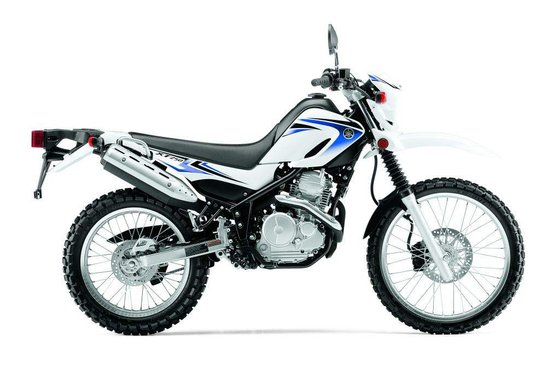
Competition: How the XT 250 Stacks Up
The dual-sport segment is fiercely contested. Here’s how Yamaha’s entry holds its ground:
Honda CRF250L
- Pros: Liquid-cooled engine, longer suspension travel (10.0”/254mm front), LED lighting
- Cons: 38lb (17kg) heavier, higher seat height (34.7”/881mm)
- XT’s Edge: Lower weight, simpler maintenance, friendlier seat height
Kawasaki KLX230S
- Pros: Modern styling, adjustable suspension, fuel injection
- Cons: Smaller 230cc engine, less aftermarket support
- XT’s Edge: Proven longevity, better parts availability
Suzuki DR200S
- Pros: Lighter (278lb/126kg), lower price
- Cons: Underpowered 199cc engine, carbureted
- XT’s Edge: Stronger low-end torque, fuel injection (post-2013)
The XT 250’s ace card is its accessibility. While competitors chase performance metrics, Yamaha focuses on ridability—a bike that won’t intimidate novices yet remains capable enough for seasoned riders seeking a stress-free daily.
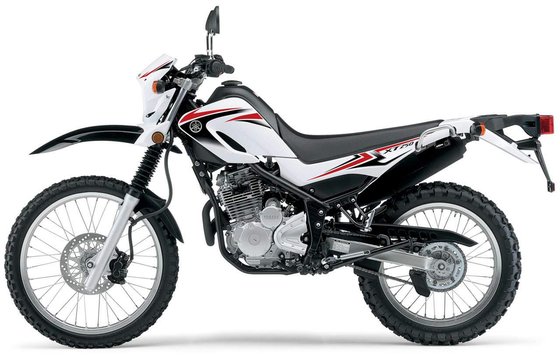
Maintenance: Keeping the Adventure Alive
Ownership costs are where the XT 250 truly shines. Its air-cooled engine eliminates radiator repairs, and valve adjustments (every 4,000 miles/6,400km) are straightforward thanks to screw-type adjusters. Key maintenance tips:
- Oil Changes: Every 3,000 miles (4,800km) with 10W-40. Consider MOTOPARTS.store’s synthetic blend for extended intervals.
- Chain Care: Clean and lubricate every 500 miles (800km). Our X-Ring chains reduce stretch.
- Air Filter: Replace annually or after dusty rides. Upgrade to a high-flow filter for off-road use.
- Suspension: Preload-adjustable rear shock suits solo riding; add a shock sock to protect seals.
- Winter Storage: Stabilize fuel and hook up a battery tender—available in our “Winter Prep Kit.”
Common upgrades from MOTOPARTS.store:
- Skid Plates: Shield the engine from rock strikes.
- Handguards: Protect levers in drops.
- Seat Covers: Improve grip during standing rides.
- LED Lighting Kits: Boost visibility without taxing the stator.
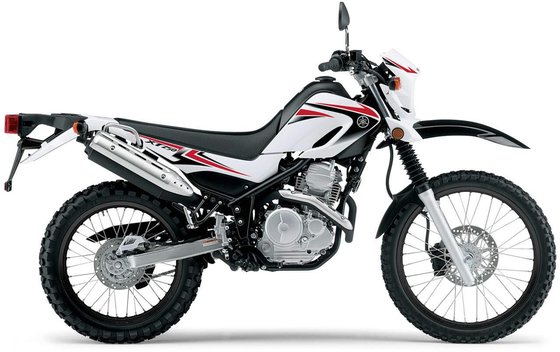
Conclusion: The Quiet Champion
The Yamaha XT 250 won’t dominate headlines or YouTube drag races, but it embodies something rare: a motorcycle that’s content being exactly what it is. It’s the Swiss Army knife of dual-sports—competent everywhere, exceptional nowhere, and utterly indispensable for riders who value substance over hype. Whether you’re a commuter seeking a traffic-weaving sidekick, a weekend warrior craving backcountry access, or a DIY enthusiast who cherishes simplicity, the XT 250 delivers. And when the time comes to personalize it, MOTOPARTS.store has the gear to make it uniquely yours.
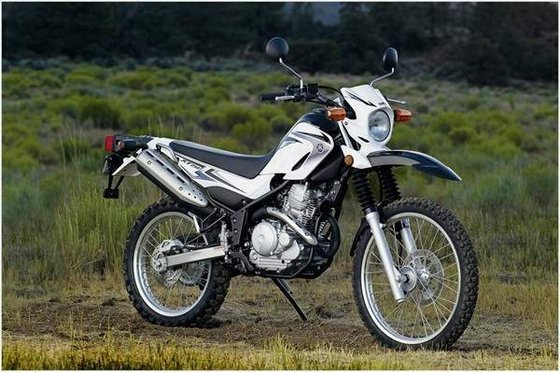
Ready to enhance your XT 250? Explore our curated selection of upgrades and replacements at MOTOPARTS.store—where every adventure begins with the right parts.







Specifikacijų lentelė
| Variklis | |
|---|---|
| Taktas: | Keturtaktis |
| Maksimali galia: | 13 kW | 17.0 hp |
| Maksimalus sukimo momentas: | 19 Nm |
| Kuro sistema: | Fuel Injection (Mikuni 33mm throttle body) |
| Tepimas: | Wet sump |
| Maksimali galia @: | 7500 rpm |
| Darbinis tūris: | 249 ccm |
| Kuro valdymas: | SOHC |
| Didžiausias sukimo momentas @: | 6500 rpm |
| Konfigūracija: | Single |
| Aušinimo sistema: | Air |
| Suspaudimo santykis: | 9.5:1 |
| Cilindrų skaičius: | 1 |
| Matmenys | |
|---|---|
| Ratų bazė: | 1359 mm (53.5 in) |
| Sausas svoris: | 123 |
| Svoris su skysčiais: | 132 |
| Sėdynės aukštis: | 810-830 mm (31.9-32.7 in) |
| Bendras plotis: | 805 mm (31.7 in) |
| Bendras aukštis: | 1161 mm (45.7 in) |
| Bendras ilgis: | 2149 mm (84.6 in) |
| Prošvaisa: | 284 mm (11.2 in) |
| Degalų bako talpa: | 9.6 L (2.5 US gal) |
| Perdavimas | |
|---|---|
| Sankaba: | Wet multi-plate |
| Galinė pavara: | chain |
| Grandinės ilgis: | 118 |
| Transmisija: | 5-speed, manual |
| Galinė žvaigždutė: | 47 |
| Priekinė žvaigždutė: | 15 |
| Techninė priežiūra | |
|---|---|
| Variklio alyva: | 10W40 |
| Stabdžių skystis: | DOT 4 |
| Uždegimo žvakės: | NGK CR8E or NGK CR8EIX |
| Uždegimo žvakės tarpas: | 0.8 |
| Variklio alyvos talpa: | 1.5 |
| Variklio alyvos keitimo intervalas: | Every 5000 km or 2 years |
| Vožtuvų laisvumas (įsiurbimo, šaltas): | 0.10–0.20 mm |
| Vožtuvų laisvumo tikrinimo intervalas: | 24,000 km / 15,000 mi |
| Vožtuvų laisvumas (išmetimo, šaltas): | 0.20–0.30 mm |
| Rekomenduojamas slėgis padangose (galinėse): | 2.5 bar (36 psi) solo / 2.8 bar (41 psi) with passenger |
| Rekomenduojamas slėgis padangose (priekyje): | 2.25 bar (33 psi) |
| Papildomos funkcijos | |
|---|---|
| Starteris: | Electric |
| Apšvietimas: | 60/55-watt halogen headlight |
| Garantija: | 1 Year Limited |
| Priemonės: | Digital LCD panel (speedometer, odometer, tripmeters, clock) |
| Važiuoklė ir pakaba | |
|---|---|
| Grėblys: | 26.4° |
| Rėmas: | Semi-double cradle steel |
| Takas: | 107 mm (4.2 in) |
| Galinė padanga: | 120/80-18 |
| Priekinė padanga: | 80/70-21 |
| Galiniai stabdžiai: | Single 203mm disc, 1-piston caliper |
| Priekiniai stabdžiai: | Single 245mm disc, 2-piston caliper |
| Galinė pakaba: | Monocross shock, adjustable preload, 180 mm (7.1 in) travel |
| Priekinė pakaba: | 35mm telescopic fork, 226 mm (8.9 in) travel |



